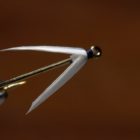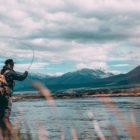

Bill Tapply had some awfully strong opinions about what makes a good bass bug.
Photo courtesy Vicki Stiefel
Bill Tapply literally wrote the book on this subject.
If you want to buy or make a good bass bug, don’t fret about what it looks like. There are more important considerations:
-
- Aerodynamics. Besides catching bass, the great fun of bass-bug fishing is identifying and casting to all those delicious targets that line a bassy shoreline—the pockets among beds of lily pads, the half-submerged trees, the dark holes under overhanging bushes, the shadows alongside boulders and docks. A badly designed bug (air-resistant wings and tails and other appendages, general bulkiness) quickly makes your casting arm ache and sucks all the fun out of it. Choose a light, streamlined bug that you can cast comfortably with a medium-weight (5 – 7 weight) rod. If you can’t find such a bug, you can improve the aerodynamics of a bulky bug with scissors.
- The Burble. The sound of prey moving on the water’s surface, not its shape or color, is what convinces bass to strike. You should be able to impart a variety of lifelike noises to a bug. Give it a sharp tug to make it go ploop. A twitch makes it burble, and with an erratic retrieve it chugs, glugs and gurgles. You can create the widest variety of seductive noises with deer-hair bugs. READ ARTICLE



